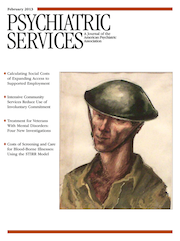Access to and Use of Non-Inpatient Services in New York State Among Racial-Ethnic Groups
Abstract
Objective
Nationwide studies contrasting service use of racial-ethnic groups provide an overview of disparities, but because of variation in populations and service systems, local studies are required to identify specific targets for remedial action. The authors report on the use of non-inpatient services regulated in New York State (NYS) and report use by the state’s larger cultural groups.
Methods
Data from the NYS Patient Characteristics Survey were used to estimate annual treated prevalence and treatment intensity, defined as the average number of annual weeks in service for non-Hispanic blacks, Hispanics, Asians, and non-Hispanic whites. The latter rates were obtained for specific types of treatment use, by person’s age and diagnosis, for the state and for population density–defined regions. Statistical methods contrasted rates of whites with other groups.
Results
A total of 578,496 individuals in these racial-ethnic groups were served in 2,500 programs, and 51% of those served were nonwhite. Treated prevalence rates of whites were lower than those of blacks and Hispanics and were substantially higher than prevalence rates for Asians. Statewide treatment intensity rates of all racial-ethnic and age groups were comparable except for lower use among Asians >65. Key findings from granular analyses were lower treatment intensity rates for black youths with disruptive disorders, Hispanic adults with anxiety disorders, and Asians >65 with depression compared with white counterparts. In upstate metropolitan areas, black youths and Hispanic adults received services in fewer weeks than whites, and in the New York City metropolitan area, whites >65 had higher treatment intensity rates than contrast groups.
Conclusions
Findings suggest a need for assistance to black families in negotiating the multiple systems used by their children, clinical training focusing on cultural symptom presentation, screening of Asians in community settings, and mandated cultural competency assessments for all programs.



